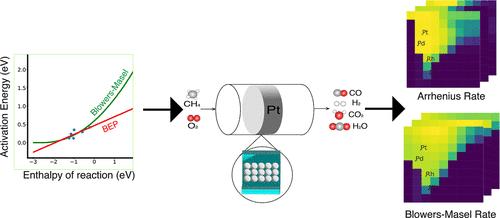当前位置:
X-MOL 学术
›
ACS Catal.
›
论文详情
Our official English website, www.x-mol.net, welcomes your feedback! (Note: you will need to create a separate account there.)
Implementing the Blowers–Masel Approximation to Scale Activation Energy Based on Reaction Enthalpy in Mean-Field Microkinetic Modeling for Catalytic Methane Partial Oxidation
ACS Catalysis ( IF 12.9 ) Pub Date : 2024-05-09 , DOI: 10.1021/acscatal.3c05436 Chao Xu 1 , Emily J. Mazeau 1 , Richard H. West 1
ACS Catalysis ( IF 12.9 ) Pub Date : 2024-05-09 , DOI: 10.1021/acscatal.3c05436 Chao Xu 1 , Emily J. Mazeau 1 , Richard H. West 1
Affiliation

|
Mean-field microkinetic modeling is a powerful tool for catalyst design and the simulation of catalytic processes. The reaction enthalpies in a microkinetic model often need to be adjusted when changing species’ binding energies to model different catalysts, when performing thermodynamic sensitivity analyses, and when fitting experimental data. When altering reaction enthalpies, the activation energies should also be reasonably altered to ensure realistic reaction rates. The Blowers–Masel approximation (BMA) relates the reaction barrier to the reaction enthalpy. Unlike the Brønsted–Evans–Polani relationship, the BMA requires less data because only one parameter, the intrinsic activation energy, needs to be determined. We validate this application of BMA relations to model surface reactions by comparing against density functional theory data taken from the literature. By incorporating the BMA rate description into the open-source Cantera software, we enable a new workflow, demonstrated herein, allowing rapid screening of catalysts using linear scaling relationships and BMA kinetics within the process simulation software. For demonstration purposes, a catalyst screening for catalytic methane partial oxidation on 81 hypothetical metals is conducted. We compared the results with and without BMA-corrected rates. The heat maps of various descriptors (e.g., CH4 conversion, syngas yield) show that using BMA rates instead of Arrhenius rates (with constant activation energies) changes which metals are most active. Heat maps of sensitivity analyses can help identify which reactions or species are the most influential in shaping the descriptor map patterns. Our findings indicate that while using BMA-adjusted rates did not markedly affect the most sensitive reactions, it did change the most influential species.
中文翻译:

在催化甲烷部分氧化的平均场微动力学模型中实现基于反应焓的鼓风机-马塞尔近似尺度活化能
平均场微动力学建模是催化剂设计和催化过程模拟的有力工具。当改变物质的结合能以模拟不同的催化剂时、进行热力学敏感性分析以及拟合实验数据时,通常需要调整微动力学模型中的反应焓。当改变反应焓时,还应合理改变活化能以确保实际的反应速率。 Blowers-Masel 近似 (BMA) 将反应势垒与反应焓联系起来。与 Brønsted-Evans-Polani 关系不同,BMA 需要的数据较少,因为只需要确定一个参数,即固有活化能。我们通过与文献中的密度泛函理论数据进行比较,验证了 BMA 关系在表面反应模型中的应用。通过将 BMA 速率描述合并到开源 Cantera 软件中,我们实现了本文演示的新工作流程,允许在过程模拟软件中使用线性比例关系和 BMA 动力学快速筛选催化剂。出于演示目的,对 81 种假设金属的催化甲烷部分氧化进行了催化剂筛选。我们比较了有和没有 BMA 校正率的结果。各种描述符(例如CH 4转化率、合成气产率)的热图表明,使用BMA 速率而不是阿累尼乌斯速率(具有恒定的活化能)会改变哪些金属最活跃。敏感性分析的热图可以帮助识别哪些反应或物种对形成描述符图模式影响最大。我们的研究结果表明,虽然使用 BMA 调整率并没有显着影响最敏感的反应,但它确实改变了最有影响力的物种。
更新日期:2024-05-09
中文翻译:

在催化甲烷部分氧化的平均场微动力学模型中实现基于反应焓的鼓风机-马塞尔近似尺度活化能
平均场微动力学建模是催化剂设计和催化过程模拟的有力工具。当改变物质的结合能以模拟不同的催化剂时、进行热力学敏感性分析以及拟合实验数据时,通常需要调整微动力学模型中的反应焓。当改变反应焓时,还应合理改变活化能以确保实际的反应速率。 Blowers-Masel 近似 (BMA) 将反应势垒与反应焓联系起来。与 Brønsted-Evans-Polani 关系不同,BMA 需要的数据较少,因为只需要确定一个参数,即固有活化能。我们通过与文献中的密度泛函理论数据进行比较,验证了 BMA 关系在表面反应模型中的应用。通过将 BMA 速率描述合并到开源 Cantera 软件中,我们实现了本文演示的新工作流程,允许在过程模拟软件中使用线性比例关系和 BMA 动力学快速筛选催化剂。出于演示目的,对 81 种假设金属的催化甲烷部分氧化进行了催化剂筛选。我们比较了有和没有 BMA 校正率的结果。各种描述符(例如CH 4转化率、合成气产率)的热图表明,使用BMA 速率而不是阿累尼乌斯速率(具有恒定的活化能)会改变哪些金属最活跃。敏感性分析的热图可以帮助识别哪些反应或物种对形成描述符图模式影响最大。我们的研究结果表明,虽然使用 BMA 调整率并没有显着影响最敏感的反应,但它确实改变了最有影响力的物种。
































 京公网安备 11010802027423号
京公网安备 11010802027423号